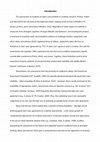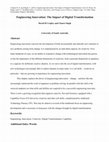Books by David Cropley

The assessment of creativity occupies a key position in creativity research. Plucker, Makel, and ... more The assessment of creativity occupies a key position in creativity research. Plucker, Makel, and Qian (2019) set out many of the important issues, ranging across all four of Rhodes's Ps: person, process, press and product (Rhodes, 1961). Regardless of which aspect of creativity is measured, from divergent cognition, through attitudes and behaviors, and including the product or outcome of creativity itself, two limitations continue to challenge scholars: subjectivity and effort. Beaty and Johnson (2021) explained these as follows. Subjectivity takes the form of limitations in inter rater agreement (p. 757). If raters can't agree on what is creative, this calls the assessments into question. Effort represents the fact that many creativity assessments require considerable investments of time, effort, and money. Together, these limitations tend to drive researchers towards methods of assessment that weaken both reliability and validity (Reiter-Palmon, Forthmann, & Barbot, 2019). Nevertheless, for assessments that rely primarily on subjective ratings, the Consensual Assessment Technique (CAT: Amabile, 1982) has typically demonstrated generally good inter-rater reliability-often exceeding .80 (Baer & Kaufman, 2019)-however, this is usually premised on the availability of appropriate experts. Assessments that use objective criteria (e.g., the Torrance Tests of Creative Thinking; Torrance, 1999) frequently demonstrate impressively high inter rater agreement (e.g., in excess of .90; Cropley, 2000). Thus, the underlying issue is not necessarily subjectivity on its own, but the high cost of achieving acceptable levels of inter-rater agreement. Beaty and Johnson (2021) explain that a reaction to these limitations-the high cost of achieving good inter-rater agreement on creativity assessments-is the recent growth of computational approaches to creativity assessment. Particularly popular among such approaches is the use of Latent Semantic Analysis (LSA: e.g., Landauer, Foltz, & Laham, 1998), in effect, automating the assessment of the fluency and originality found in traditional tests of divergent thinking. Beaty and Johnson (2021) give a comprehensive overview of the application of semantic

This book explores the history of modern human creativity/innovation, highlighting examples of so... more This book explores the history of modern human creativity/innovation, highlighting examples of solutions to basic human needs that have been developed over time. The title-Femina Problematis Solvendis-is a play on the scientific classifications of humans (Homo habilis, Homo erectus, Homo sapiens), but with special focus on inventions pioneered by women ("femina") and is intended to suggest that a defining characteristic of modern humans is our fundamental ability to solve problems (i.e., problem-solving woman = Femina problematis solvendis), Written by David H. Cropley, an internationally recognised expert on creativity and innovation, it also builds on his previous book "Homo Problematis Solvendis-Problem-solving Man", published in 2019. The book explores innovations over ten distinct "ages" of human history, beginning with "prehistory", and moving up to the present "information age". Each era is covered by a dedicated chapter that describes three key innovations that were either definitely invented by a woman or can be plausibly attributed to a female inventor. The book's focus on female inventors also serves to highlight some of the ways women have been treated in societies over time. David Cropley is an internationally recognised expert on creativity and innovation. His teaching interests focus on systems engineering and related concepts, and his research examines a range of aspects of creativity and innovation, both in the field of engineering, and more broadly, in education and organisations.
Cover image and ToC from forthcoming book: Homo problematis solvendis - Problem solving Man: A hi... more Cover image and ToC from forthcoming book: Homo problematis solvendis - Problem solving Man: A history of human creativity, Springer Nature. Publication Feb 2019.
Cover image of forthcoming German version of "Creativity and Crime: A Psychological Analysis".
Book Chapters by David Cropley
International Handbook of Creative Cognition, 2023

Creativity, Innovation and Change Across Cultures, 2023
Engineering innovation concerns the development of both incrementally and radically new solutions... more Engineering innovation concerns the development of both incrementally and radically new solutions to new problems arising from change. It is underpinned by an individual capacity for creativity. Over many hundreds of years, as our ability to respond to change with technological innovation has grown, so has the importance of the different dimensions of creativity, from a personal disposition to openness, to a capacity for deliberate creative ideation. As we move into the era of digital transformation, with new technologies increasingly able to replace humans in many tasks, it is soft skills-creativity in particular-that are growing in importance for engineering innovation. This chapter explores the driver of [engineering] innovation-change-and how this has increasingly redirected the work of engineers to problem solving. In parallel with this shift is the renewed emphasis on what skills and abilities are required to be a successful engineering innovator. There is now a growing recognition that engineers must be, first and foremost, equipped with a Capability Focus (CF) driven by creativity and other soft skills, complimented by traditional Technology Fluency (TF). This may be almost a reversal of the traditional focus on engineering development and is necessary to keep pace with the changes brought by digital transformation.
Handbook of Organisational Creativity: Volume 2: Leadership, Interventions and Macro Level Issues, 2023
Cyber-physical systems (CPSs) are impacting an increasingly broad range of aspects of life, bring... more Cyber-physical systems (CPSs) are impacting an increasingly broad range of aspects of life, bringing widespread and rapid change. One consequence of this is that engineering work is becoming open-ended, requiring a new kind of collaboration between engineers and technology. The present chapter argues that this particular instance of the future of work will

Unpacking Creativity: Culture, Innovation, and Motivation in Global Contexts, 2023
The field of creativity research, in its modern sense, has existed for some 70 years. Initially d... more The field of creativity research, in its modern sense, has existed for some 70 years. Initially driven by questions anchored in education, creativity research has branched out over the last 70 years to touch on many areas of human activity. However, it can be argued that the discipline has, in those 70 years, failed to make a deep and lasting impact in areas such as education. Despite strong interest in creativity, many countries still struggle with the issue of how to develop and assess creativity across the range of disciplines. A key cause of this gap between research and practical application, especially in education, but also in business, may be a problem of measurement. In particular, the issue is a matter of the fitness-forpurpose of creativity measurement. This can be understood in terms of five key factors: (a) domainspecificity; (b) consistency and trustworthiness; (c) classroom integration; (d) speed of results, and (e) cost.
Creativity and Morality, 2022
Creativity is regarded typically as a universal, beneficial force, driving positive outcomes acro... more Creativity is regarded typically as a universal, beneficial force, driving positive outcomes across a range of areas of human activity, including technology. Despite this, however, there is a thread of research that acknowledges a dark side to creativity. For example, technology, in its broadest sense, has given the world life-saving vaccines. However, that same technology has also been misused to create biological weapons. The purpose of this chapter is to explore the role that individual morals, in particular, as well as societal/organizational ethics, play in shaping (and constraining) creativity the world of technological problem solving and design (i.e., technological creativity). How is it possible to balance the need for freedom that creative design requires, with the inherent constraints imposed by ethics?
Creative Provocations: Speculations on the Future of Creativity, Technology and Learning, 2022
Creativity and Innovation: Theory, Rsearch, and Practice, 2022
Change-climate, economic, demographic, social-creates new problems. • Creativity is about finding... more Change-climate, economic, demographic, social-creates new problems. • Creativity is about finding new solutions to those new problems. • Creative solutions-or products-can take many forms (e.g. artifacts or services). • Product creativity can be measured, and what can be measured can be improved.
Uploads
Books by David Cropley
Book Chapters by David Cropley
“Design Wars,” an all-day team design competition modeled on
reality television competitions such as Project Runway or
Junkyard Wars. The purpose of the competition was to test the
student teams’ abilities to develop creative solutions to an open
ended problem given limited time and unconventional resources.
One question that arose while developing the competition was the
impact that individual creativity and team creative composition
would have on the final product. The results were somewhat
surprising; teams with the highest average scores of individual
creativity performed the worst in judging of the creativity of the
final product. While the reasons for this are unclear, the most
likely reasons were a) lack of time to incubate creative ideas b) an
inability to articulate creative ideas physically in the constructed
project or c) a limit in the ability of creative, or divergent,
thinkers to converge upon a single solution. Additionally, teams
that had a large range of individual creativity scores, or more
specifically, a single dominant “creative” thinker, also failed to
score well in the creativity potion of the competition The current
work in progress examines the composition of design teams to
develop a taxonomy based on a) average team scores of
individual team member creativity and b) range of individual
creativity on a team. Based on the Innovation Phase Model
(IPM), different phases of innovation emphasize different
dominant thinking processes. The IPM includes the stages of
Invention (preparation, activation, generation, illumination,
verification) and Exploitation (communication and validation).
Teams that excel in invention may not excel in exploitation.
Alternatively, some teams may actualize their ideas very well, but
may not have the same ability to generate fluency and flexibility
and novelty in their solutions. By categorizing team
characteristics, we can examine if specific team compositions are
more likely to perform well in specific phases of the IPM. The
current focus is on the divergent stages of Invention including
activation (problem definition) and generation (fluency in
solutions) as well as the convergent stage of illumination
(reduction to a few promising solutions.) The overall objective
will be to develop strategies specific to team composition that
improve performance in all phases of innovation.
I hope that together, these chapters and papers give readers a single source that presents a reasonably unified picture of the nature of creativity in the engineering domain.
Follow this link to participate. Please copy and paste the link with other people whom you have online access to (e.g., email, social media, online blogs, circulating it through work). Anyone over the age of 18 years can participate. Your help participating in and promoting this survey is greatly appreciated.
This project has been approved by the University of South Australia’s Human Research Ethics Committee (Approval #: 34214). If you have any ethical concerns about the project or questions about your rights as a participant, please contact the Executive Officer of this Committee at +61 88302 3118 or by email at Vicki.Allen@unisa.edu.au
Rebecca McBain
MHPU (Hons) Candidate
School of Psychology, Social Work and Social Policy
University of South Australia
To download the app, please go to: https://play.google.com/store/apps/details?id=com.csdsrubrik.id&hl=en